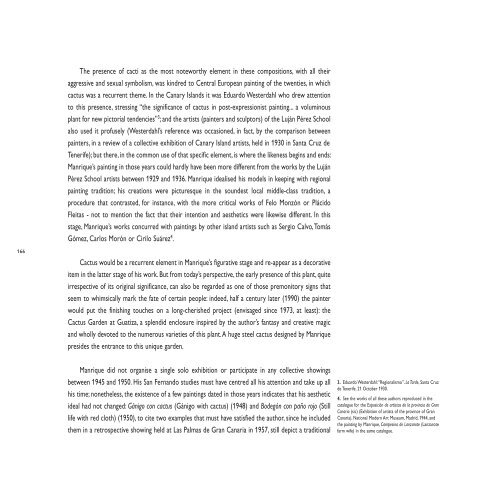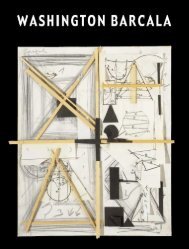VERSIÓN INGLESA ENGLISH VERSION - Fundación César Manrique
VERSIÓN INGLESA ENGLISH VERSION - Fundación César Manrique
VERSIÓN INGLESA ENGLISH VERSION - Fundación César Manrique
Create successful ePaper yourself
Turn your PDF publications into a flip-book with our unique Google optimized e-Paper software.
166<br />
The presence of cacti as the most noteworthy element in these compositions, with all their<br />
aggressive and sexual symbolism, was kindred to Central European painting of the twenties, in which<br />
cactus was a recurrent theme. In the Canary Islands it was Eduardo Westerdahl who drew attention<br />
to this presence, stressing “the significance of cactus in post-expressionist painting... a voluminous<br />
plant for new pictorial tendencies” 3 ; and the artists (painters and sculptors) of the Luján Pérez School<br />
also used it profusely (Westerdahl’s reference was occasioned, in fact, by the comparison between<br />
painters, in a review of a collective exhibition of Canary Island artists, held in 1930 in Santa Cruz de<br />
Tenerife); but there, in the common use of that specific element, is where the likeness begins and ends:<br />
<strong>Manrique</strong>’s painting in those years could hardly have been more different from the works by the Luján<br />
Pérez School artists between 1929 and 1936. <strong>Manrique</strong> idealised his models in keeping with regional<br />
painting tradition; his creations were picturesque in the soundest local middle-class tradition, a<br />
procedure that contrasted, for instance, with the more critical works of Felo Monzón or Plácido<br />
Fleitas - not to mention the fact that their intention and aesthetics were likewise different. In this<br />
stage, <strong>Manrique</strong>’s works concurred with paintings by other island artists such as Sergio Calvo, Tomás<br />
Gómez, Carlos Morón or Cirilo Suárez 4 .<br />
Cactus would be a recurrent element in <strong>Manrique</strong>’s figurative stage and re-appear as a decorative<br />
item in the latter stage of his work. But from today’s perspective, the early presence of this plant, quite<br />
irrespective of its original significance, can also be regarded as one of those premonitory signs that<br />
seem to whimsically mark the fate of certain people: indeed, half a century later (1990) the painter<br />
would put the finishing touches on a long-cherished project (envisaged since 1973, at least): the<br />
Cactus Garden at Guatiza, a splendid enclosure inspired by the author’s fantasy and creative magic<br />
and wholly devoted to the numerous varieties of this plant. A huge steel cactus designed by <strong>Manrique</strong><br />
presides the entrance to this unique garden.<br />
<strong>Manrique</strong> did not organise a single solo exhibition or participate in any collective showings<br />
between 1945 and 1950. His San Fernando studies must have centred all his attention and take up all<br />
his time; nonetheless, the existence of a few paintings dated in those years indicates that his aesthetic<br />
ideal had not changed: Gánigo con cactus (Gánigo with cactus) (1948) and Bodegón con paño rojo (Still<br />
life with red cloth) (1950), to cite two examples that must have satisfied the author, since he included<br />
them in a retrospective showing held at Las Palmas de Gran Canaria in 1957, still depict a traditional<br />
3. Eduardo Westerdahl: “Regionalismo”. La Tarde, Santa Cruz<br />
de Tenerife. 21 October 1930.<br />
4. See the works of all these authors reproduced in the<br />
catalogue for the Exposición de artistas de la provincia de Gran<br />
Canaria (sic) (Exhibition of artists of the province of Gran<br />
Canaria), National Modern Art Museum, Madrid, 1944, and<br />
the painting by <strong>Manrique</strong>, Campesina de Lanzarote (Lanzarote<br />
farm wife) in the same catalogue.
















![Becas y premios de la Fundación César Manrique [1997-2006]](https://img.yumpu.com/20766851/1/184x260/becas-y-premios-de-la-fundacion-cesar-manrique-1997-2006.jpg?quality=85)
